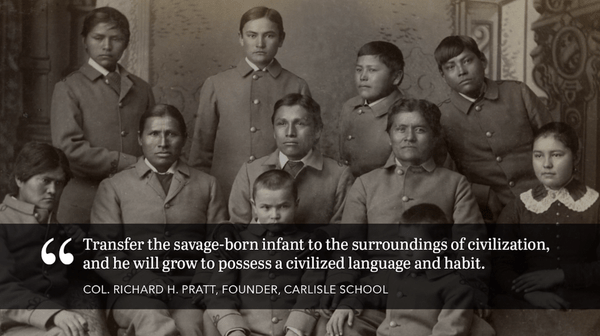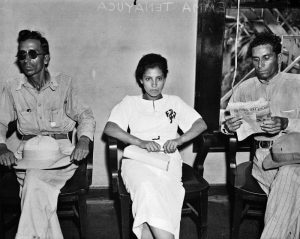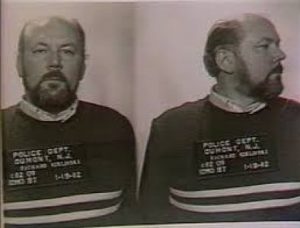Going to school for the first time is always rough. It’s every child’s annoyance and even disdain when it comes to school. Carlisle seemed like any ordinary school. It had classrooms, teachers, libraries, things that any school would have. Only this school had a unique purpose. This school was not for everyone; in fact, it was only for one group of people: Native American children. The purpose of this school was to strip these Native American children of every native tradition and custom they ever had. Their traditional clothing made of soft leather and Mulberry and redwood bark were replaced with uniforms.1 These childrens’ names were officially changed to Christian names, and they were forbidden to speak their native languages while on school premises; all teaching instruction was in English.2 Additionally, both boys and girls had to have their hair cut to an appropriate length, which was based on Anglo-Saxon cultural norms. After the students had their hair cut and their Native garb removed, they would have to choose a Christian denomination.3 The one connection the students had to their culture was one ritual dance that was performed by the students for the comic entertainment for visitors. Any other traditional dances or rituals were prohibited.4 How did this school come about?

After multiple failures of the United States government to suppress Native Americans though the use of brutal military campaigns, Thaddeus Pound, a third-term US congressman, promoted the idea of assimilation. In 1881, he proposed that it would be cheaper and easier to assimilate Native Americans rather than to continue fighting them. Stressing the civilizing of Native peoples, Pound pressured Congress that this had to be done for humanitarian purposes. The real purpose, however, was to sever the children culturally and psychologically from their culture, thus saving the Indian but at the same time destroying them by destroying their culture.5 Through this debate came the notion of educating Native children into white culture and erasing their culture through the use of forced assimilation.
The Carlisle Indian Industrial School opened in 1879 in Carlisle, Pennsylvania, by Lieutenant Richard Henry Pratt with 136 Native American Children.6 However, at the turn of the decade, the federal government acknowledged assimilation practices as Indian Policy. Carlisle then became approved as a role model for other off-reservation schools, which led to the creation of twenty-three other similar schools.7 By 1902, the number of such schools had jumped to ninety-two schools managed by the Federal government nation-wide.8 The Carlisle Indian Industrial School focused mostly on teaching low level skills to children, training them for jobs as servants and manual laborers. Education at Carlisle only lasted three years with a focus on basic English, math, writing, and labor skills.

Over time, classes grew to include students who graduated from the eighth grade and higher levels of education. After graduating, most students returned to the reservation to do small jobs such as shoe making, printing, or tailoring. Unfortunately, most of these trades proved useless on the reservations.9 Carlisle, along with other off-reservation schools across the US, held large celebrations and parades dedicated to showing the transition of students from Natives to Anglo-Saxon Americans through the use of parades, floats, and the occasional play. Most of these carried offensive and racist messages, such as “Anglo-Saxons rule the world, we submit” and “wise statesmanship demands a homogeneous population,” which were used to promote and prove the power of assimilation over Native-American populations. This led to the belief that Native culture was just a dream and not something that will grow into the Anglo-Saxon culture.10

Carlisle also sponsored extracurricular activities, which included a music program, a student-run newspaper, and a library. Most of these programs were unintended by the federal government and were created mostly by donors, teachers, and the students themselves. For instance, the library was created through the efforts of O.H. Bakeless and Pratt, who wanted Native children to have access to encyclopedias, medieval stories, and Greek and Roman history. Along with that, they added classics such as Little Women, Black Beauty and religious texts. Teachers and sponsors also played a key roles in growing the school and encouraging pupils to grow outside of the low level jobs the federal government intended for them, by providing additional funds and resources.11
The Carlisle experience had lasting repercussions for these children. Some children were able to leave reservations and find substantial employment, but unfortunately, the overall effects leaned towards the negative rather than the positive spectrum. Children experienced cultural isolation, which led to homesickness, and in extreme cases, to alienation and depression when they returned to reservations. Families that were reluctant to send their children to federal schools faced threats from the government that included removing federal funding and welfare from the family. Hence, even if the child or the family didn’t want to attend Carlisle or other schools, they had no choice. 12 Gertrude Bonnin, also known as Zitkala-sa, was a former student from Carlisle and went on to become a teacher at the school. She, like many students, had been scouted out by missionaries prior to attending Carlisle Indian Industrial School. In her case, she was recruited by the Manual Labor Institute, a Quaker mission school in Indiana. She was recruited at the age of eight, and she recalled the traumatic experiences she and others faced when going through the assimilation process. In her essay, School Days, she recalls how she hid from teachers when they told her they were going to cut her long, traditional braids. They ended up dragging her out from under a bed, tying her to a chair, and then cutting her braids with a pair of scissors. She describes this moment as the moment she lost her spirit. After Carlisle, she found herself alienated from her traditional mother and struggled to reconnect with her family for the rest of her life. She became a teacher at Carlisle for two years before going on to found the National Council of American Indians in 1926, where she served until her death in 1938. She was a prominent Native-American rights activist.13

After years of forced assimilation, the connection between the Native Americans and the Federal government became extremely fragile. With that, Native Americans decided to create laws that only effected Native Americans. The federal government agreed to this in order to reconcile with the Native peoples and let these special laws pass. The major laws were aimed towards Native-American children with the most famous one being the creation of ICWA or the Indian Child Welfare Act.14
Out of the 10,000 that went into Carlisle, 186 children from nearly fifty different tribes died, most dying of illnesses such as tuberculosis, influenza, and trachoma, an infectious eye disease. Tuberculosis, however, was the deadliest of the three. Families of the deceased children could not claim the bodies of the children, so the children’s bodies were never returned to the tribe. The children instead were given Christian burials and were buried in the Carlisle cemetery. It wasn’t until the year 2000 that the children were given proper Native burial rites, but unfortunately, the correct identification of each body had been lost due to time, loss of accurate documentation, and several relocation projects on the Carlisle Cemetery. The school is now an active military base with the cemetery located right behind the army barracks known as the Carlisle Barracks.15
- Fashion, Costume, and Culture: Clothing, Headwear, Body Decoration, and Foot wear through the Ages, 2013, s.v. “Clothing of Native American Cultures,” by Sara Pendergast, Tom Pendergast, Drew D. Johnson, and Julie L. Carnagie. ↵
- Encyclopedia of Genocide and Crimes against Humanity, 2005, s.v. “Native Americans,” by Stacie E. Martin. ↵
- Mary A. Stout, Native American Boarding Schools (Santa Barbara: ABC-CLIO LLC, 2012), 32, 34, 36. ↵
- American Eras: Primary Sources, 2013, s.v. “The Indian School at Carlisle Barracks,” by Rebecca Parks. ↵
- Scott Laderman, “‘It is cheaper and better to teach a young Indian Than to Fight an Old One’: Thaddeus Pound and the Logic of Assimilation,” American Indian Culture And Research Journal 26, no.3 (2002): 9-10. ↵
- Encyclopedia of Race and Racism, 2013, s.v. “American Indian Boarding Schools,” by Jon Reyhner. ↵
- Mary A. Stout, Native American Boarding Schools (Santa Barbara: ABC-CLIO LLC, 2012), 42. ↵
- American Eras: Primary Sources, 2013, s.v. “The Indian School at Carlisle Barracks,” by Rebecca Parks. ↵
- Mary A. Stout, Native American Boarding Schools (Santa Barbara: ABC-CLIO LLC, 2012), 38, 42. ↵
- John R. Gram, “Acting out Assimilation: playing Indian and becoming American in the federal Indian boarding schools,” The American Indian Quarterly 40, no. 3 (2016): 1-5. ↵
- Bernadette A. Lear, “Libraries and Reading Culture at the Carlisle Indian Industrial School,” Book History 18, (2015): 168, 173. ↵
- Encyclopedia of Race and Racism, 2013, s.v. “American Indian Boarding Schools,” by Jon Reyhner. ↵
- Mary A. Stout, Native American Boarding Schools (Santa Barbara: ABC-CLIO LLC, 2012), 36-37. ↵
- Timothy Sandefur, “Suffer the Little Children: US laws treats Native American Children very different from Other Children,” Regulation 40, no. 4 (2017): 1-3, 5. ↵
- Jacqueline Fear-Segal, “Institutional Death and Ceremonial Healing far from Home: The Carlisle Indian School Cemetery” Museum Anthropology 33, no. 2 (September 2010): 157-159, 164-165. ↵



53 comments
Reagan Meuret
This article just goes to show that the United States government went to some horrible extremes in the past. It is so sad and hard to imagine what they must have gone through while at the school. It is just good that they are no longer in practice and they wont ever come about again hopefully. This article was great at informing me of the terrible things that happened to those poor children.
Lorenzo Rivera
This article is extremely well written and in my case it hits very close to home, due to the fact that my great grandfather was sent to one of these boarding schools when he was a child. He would always tell me about how they forced them to speak English, and worked to ensure that the traditions of native Americans would soon die away. This article shows the forced assimilation that these children were forced to undergo.
Aneesa Zubair
Like most students, I learned about the forced assimilation of American Indians in high school, but never in so much detail. Your article is very well-researched and informative. The before-and-after picture showed how drastically the students’ culture had been affected. I also had never heard about the celebrations with racist messages or Gertrude Bonnin’s story, both of which were saddening. The assimilation of Native Americans overall was such an awful process and it was devastating to learn about how it affected the lives of so many people.
Sofia Andrade
Reading this article made me sad because the people with power and authority always find a way to get what they want. These children were stripped of their identity by receiving an “education”. The assimilation school affected these children in a negative way more than they helped them. In reading this article I learned about assimilation schools, something I had never heard before.
Martina Rodriguez
The attention to detail given in this article made the atrocities read about that much more gut wrenching. The author does very well at providing examples and commentary on the various wrongdoings that went on at the Carlisle school. The extensive research that went into this article drives the point that much farther home. Especially when the focus shifted to the after effects of leaving the school. Even more impressive was the use of quotation from an actual survivor.
Didier Cadena
The article does a great job of telling the story of one of the ways that assimilation was used. It was tragic to read about all of the deaths that were caused because of negligence and disease at the school. To strip one of their origins and roots is a truly terrible thing. It was also sad to read that most of those buried could not be given a proper native American burial because of the misidentification of the bodies.
Andrew Dominguez
This was a very interesting article, and shows the cruelty the native Americans experienced. What i found to be awful was the children would be stripped of their culture, and have to learn traits which wouldn’t apply when they would return back to their homes. I don’t understand why the government would want to destroy their proud culture hadn’t they taken enough already from the native Americans.
Kayla Lopez
From the very beginning of this article, I was hooked and wanted to continue reading more. Everything the Native Americans had to go through was very unjust and inexcusable. There are never any reasons for people to think that they are more superior than others and thus have more rights to things, such as land. This article was very interesting and I truly did enjoy reading it, despite the topic being very sad.
Timothy ODekirk
This was an interesting article to read. My knowledge on Native American history is limited; however, I am insinuated greatly with it and am intrigued to be able to learn more about this kind of history. As far as America had been United, there has always been racism and segregation amount others. I feel like having special schools for Native American children was a form of segregation in many ways. It’s also crazy to learn how most kids were shipped away as young as 7, to never see their parents again for years to come. This was such a fasinating article and was well worth the read.
Joshua Castro
I always find it hard to believe how cruel the American government was towards the Native Americans. It had no remorse or regrets when carrying out their goal of wiping their culture out of existence. Even though I have heard many accounts of the feud between Native Americans and the government, I can never understand why there can’t be peace. Why try to interfere by forming to one specific culture? This was a very interesting article!